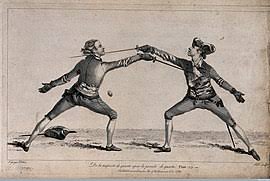The collapse of the history of European fencing (Part Three)
 “No war – no fencing!”
“No war – no fencing!”
Why is it? Who needs fencing? Who else needs a military system? Only an aggressive state waging war of conquest no one needs any more system. For example, an aborigine does not need such military science at all. And by any fate he cannot even think about this, and there are his reasons for that. The native has completely different needs: to get a banana or coconut and feed the family, but protect it from predators. Why does he need a “military system”? It’s better to tell how to get meat on hunting or catch fish. More than once Bram Frank and other masters of fencing of our time drew attention to this.
Further, I would like to talk with you about the secrets of this treatise. And although the work on the translation is now in full swing, literally in full swing, we already know something, and I will not premium to share these secrets with you.
The first secret – I would even call it a “historical riddle” – concerns what, it turns out, already in 1711, in the years when de Rada wrote his works, in Mexico there already exists a specialized educational institution called the Academy of Deception. “Who created this academy?” You ask. And really, who is its ancestor? And, not knowing thoroughly the Neapolitan fencing and its styles, it is difficult to answer this question; however, as a result of five years of expeditionary activity and research in southern Italy, as well as as a result of the restoration of the Neapolitan military system, we definitely know: the ancestor is the King of Deception, as he was called during his lifetime, Maestro Antonio Matthew.
Guess who patronizes the Academy of Deception? Already familiar to us is Francisco Lorenzo de Rada, a knight of the Order of St. Santiago. And I dare say, “all in a row” did not get into this academy – only “chosen people”.
The second mystery. At the beginning of the story about the system, de Rada describes a certain “Indian stand” and says that “… no one uses this stand”. That is, no one before in any treatise before Mr. de Rada spoke about this rare stand, and only representatives of the Mexican Academy of Deception used it. The style itself is called by him “beautiful Spaniard.”
The mystery of the third. The first logical model appears! And for Spain, this model is rather strange, because this “living creature” does not live in Spain. This is a SCORPIO. And this is not just a logical model! “Scorpio” subsequently turns into a criminal tattoo, which is characteristic of all Hispanic countries and their criminal traditions. Scorpion is beaten on the right hand; the owner of such a tattoo is a killer, a knife master, someone who kills other people, in particular, can be a hired killer. The scorpion tattoo exists today, and it is symbolically no less important than, for example, the spider tattoo. (The spider beats on the left hand, the scorpion on the right). The “Spider” tattoo means that its owner is an authoritative person in the criminal world. “Scorpio” says that in front of you is a knife master.
We return to the treatise de Rada and give the following quote:
“A scorpion is the animal that most vividly represents betrayal, because it hugs with two claws that it has, fawns with signs of sympathy and love, wielding its tail. But he did not caress, bending his seven joints at the back, inflicting a fatal bite.
“… those who follow this teaching, between their silky words, follow the strong paths of their design, although these paths can lead to death.”
What is the point of view of fencing? In fact, we are dealing with a kind of “threefold” system. In particular, as a result of the coupling of the two hands of the opponents, a certain “extra third hand” arises – this is the logical embodiment of the “scorpion tail”.
And this same logical model indicates the principle of the “three points”. Moreover, it is here that kicks first appear.
Suppose we grabbed a “cloak”, worked out the hugging “scorpion claws” – and then kicks were used.
As you can see, the style of “beautiful Spanish” involves kicks.
Mystery Four. The geometric justification of the rare “Indian stand” is also given in this treatise on the example of two models implying the presence of a spear. The stand is quite complex: in it the left leg is in front; pay attention to the position of the “spear”:
This stance allows you to move in different directions – both inward, towards the enemy, and outward. Moreover, the use of an “Indian stand” implies the creation of a certain “dead zone” for an opponent, which in a duel is fraught with danger for the enemy. The “dead zone” can be removed by changing the distance of striking for the enemy.
As you know, de Rada did his work in the 1700s. writes not for “modern journalists of the cut of the 21st century”, but in response to the statements of one of the graduates of the same Academy of Deception, Diego Rodriguez de Guzman.
And this is only the first treatise, the first work of Francisco de Rada, which we generally began to study …




